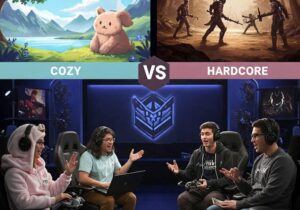Hideo Kojima, a name synonymous with innovative video game design, has significantly shaped the gaming industry over the past few decades. His career began in the early 1980s, but it was the launch of the Metal Gear series in 1987 that catapulted him into the limelight. Kojima is not only a game designer but also a director and producer known for his unique storytelling abilities, intricate gameplay mechanics, and ambitious vision. His creations often blend cinematic elements with interactive experiences, elevating video game narratives to new heights.
One of Kojima’s hallmark projects, the Metal Gear series, introduced concepts such as stealth gameplay and narrative complexity that were groundbreaking at the time. The series’ protagonist, Solid Snake, has become an iconic character within the gaming community. Each installment in the series, particularly Metal Gear Solid, has garnered critical acclaim for its thought-provoking themes, addressing issues such as war, technology, and politics, which resonate with audiences on multiple levels.
Besides the Metal Gear series, Kojima has ventured into various projects that showcase his creativity and forward-thinking approach, including the widely-acclaimed Death Stranding. This game, released in 2019, further exemplifies his tendency to defy conventions and explore new gameplay paradigms. His work blurs the boundaries between gaming and art, prompting discussions on the nature of interaction and storytelling in the digital age.
Kojima’s influence extends beyond individual titles; he has inspired a generation of developers and designers who draw on his pioneering methods. His contributions have redefined what video games can achieve, not merely as entertainment but as a medium capable of conveying deep narratives and complex emotional experiences. This transformative impact cements Hideo Kojima as a pivotal figure in the evolution of video games, captivating audiences and challenging the status quo in the industry.
Innovative Storytelling Techniques
Hideo Kojima has consistently employed innovative storytelling techniques that set his works apart in the gaming industry. Characterized by multi-layered narratives and complex themes, Kojima’s storytelling method challenges traditional paradigms and enhances player engagement. His games often feature intricate plotlines that interweave various genres, creating a rich tapestry that demands player attention and participation.
One of his hallmark strategies includes the incorporation of nonlinear storytelling. Rather than adhering to a straightforward narrative arc, Kojima frequently opts for a fragmented approach, allowing players to piece together the story while navigating through diverse gameplay experiences. This technique not only reflects the complexities of modern life but also encourages players to become active participants in the narrative construction process. Through this method, players must confront and interpret various perspectives, fostering a deeper understanding of the intertwined themes present in his titles.
Moreover, Kojima excels in character development, crafting fully realized personas that resonate with players on an emotional level. Each character often embodies a unique ideology, allowing players to explore conflicting motivations and moral dilemmas. This depth enables a nuanced examination of human relationships, ethics, and existential questions within the gaming narrative. The emotional connection established through these characters enhances player motivation to engage with the story, propelling them toward deeper exploration of the game world.
Furthermore, Kojima’s use of multimedia elements, such as cinematics and music, serves to augment the immersive experience. By integrating these components seamlessly into gameplay, he elevates the storytelling process beyond mere interactivity, transforming it into a form of artistic expression. Each game becomes a shared experience that captivates players, leaving a lasting impact that extends beyond the screen. Through these innovative storytelling techniques, Hideo Kojima’s creations continue to surprise and engage audiences, redefining the boundaries of video game narratives.
Technical Advancements in Game Design
Hideo Kojima is renowned for his ability to harness technological advancements in game design, pushing the boundaries of interactive entertainment. Over the years, he has adeptly integrated state-of-the-art technologies into his projects, resulting in deeply immersive experiences for players. His 2019 release, Death Stranding, serves as a prime example of this innovative approach. Utilizing the Decima Engine, developed by Guerrilla Games, Kojima was able to deliver stunning visuals and detailed environments, allowing players to engage in a world that feels both expansive and organic.
The game features realistic terrain generation and advanced physics, enhancing the gameplay experience. From the way characters move through the environment to the physics of objects interacting within it, these technical advancements play a crucial role in creating a believable setting. For instance, the introduction of ‘social strand system’ in Death Stranding leveraged connectivity, allowing players’ actions to indirectly influence one another in a shared game world, showcasing how technology can enhance social interaction.
Moreover, Kojima’s emphasis on sound design further illustrates his innovative spirit. In Death Stranding, ambient sounds and audio cues are meticulously crafted to provide players with essential information about their surroundings. This astounding attention to detail not only contributes to immersion but also utilizes the latest audio technology to create a multi-layered auditory experience. Through these advancements, Kojima has shown that advancements in technology can facilitate storytelling and emotional depth in video games.
By continually exploring new technologies, Kojima consistently surprises audiences, proving that he is not just a game designer but a visionary who understands how to blend narrative and innovation seamlessly. His ability to adapt to and incorporate these advancements keeps his work fresh and engaging, resonating with both longtime fans and new players alike.
The Surreal and the Unexpected
Hideo Kojima’s games are renowned for their surreal and often bizarre elements, which consistently set them apart from traditional offerings in the gaming industry. This affinity for the unconventional captivates audiences, drawing them into narratives that blur the lines between reality and the fantastic. From the existential themes in “Metal Gear Solid” to the mind-bending gameplay mechanics in “Death Stranding,” Kojima’s universe is one where the unexpected is the norm.
One of the most striking aspects of Kojima’s creative approach is his ability to weave complex narratives that challenge players’ expectations. Rather than adhering strictly to established tropes, he often opts for plot twists that leave audiences questioning the very nature of their in-game realities. For instance, the fourth wall is often broken, with characters addressing the player directly, thus creating an immersive experience that transforms viewers into active participants in the unfolding drama. This technique not only heightens player engagement but also elevates the narrative to a level that transcends traditional storytelling.
Additionally, Kojima’s penchant for surrealism serves to evoke emotional responses that resonate long after gameplay concludes. The juxtaposition of absurdity and profound themes encourages players to reflect on their own lives and experiences. The way he incorporates bizarre elements serves as a vehicle for exploring heavy topics such as war, isolation, and the complexities of human relationships.
Ultimately, the unexpected nature of Kojima’s work fuels intrigue and elevates player experience. By defying conventional gaming norms, he creates a landscape where every encounter can lead to the surreal, ensuring that players remain engaged and eager for what comes next. This unique approach leaves a lasting impact and affirms Kojima’s status as a visionary in the gaming industry.
Cultural Commentary and Social Commentary
Hideo Kojima, the acclaimed video game designer and director, has long been recognized for his ability to infuse social and cultural commentary into his works. Through his storytelling and gameplay mechanics, Kojima engages players in discussions about pressing real-world issues, philosophical dilemmas, and ethical quandaries. This unique approach transforms his games from mere entertainment into rich narratives that compel players to reflect on their own beliefs and societal norms.
One of Kojima’s most notable games, “Metal Gear Solid,” tackles themes such as nuclear proliferation, the consequences of war, and the complexities of human nature. The intricate narratives encourage players to question the motives behind global conflicts, often distinguishing between right and wrong in morally ambiguous scenarios. By placing gamers in positions where they must make difficult choices, Kojima fosters critical thinking and self-reflection on what it means to be human in times of crisis.
Furthermore, in “Death Stranding,” Kojima explores the concepts of isolation, connection, and the impact of technology on human interactions. This game serves as a commentary on contemporary society’s struggle with loneliness, particularly in an age dominated by digital communication. Players navigate a fragmented world, where the importance of collaboration and empathy becomes paramount. Through such mechanics and narratives, Kojima invites his audience to consider how to foster relationships in a disconnected environment.
The depth of Kojima’s work lies not just in the fascinating storytelling, but in his capacity to provoke thought and discussion among players. By weaving social and cultural narratives into the fabric of his games, he elevates the medium to a platform for dialogue about relevant topics that resonate far beyond the screen. This distinctive approach has established Kojima as a profound voice in the realm of video games, as he continually inspires players to engage with the world around them from new perspectives.
Engaging with Fans and Community
Hideo Kojima has mastered the art of engaging with his fanbase, fostering a vibrant community that amplifies the excitement surrounding his projects. His approach is multifaceted, leveraging social media platforms to create an interactive environment where fans feel valued and involved. Through channels like Twitter and Instagram, Kojima shares insights about his creative process, offering glimpses of his upcoming works while inviting fans into his world. By actively responding to fan queries and acknowledging their creative contributions, he cultivates a sense of belonging among his supporters.
One of Kojima’s notable strategies is the use of cryptic teasers and enigmatic announcements, which serve to pique curiosity and encourage speculation. This method not only fuels discussions among fans but also transforms the anticipation of his projects into a collective experience. The dedicated followers engage in dialogue, theorizing about plot developments and gameplay mechanics, which further deepens their investment in his creations. This communal engagement is instrumental in building a dynamic narrative around his work that goes beyond the game itself.
Kojima has also embraced the narratives and discussions that arise within fan communities, often integrating their feedback into his projects. By doing so, he not only acknowledges the influence of his audience but also elevates fan engagement to a collaborative level. Events, both online and offline, such as game launch parties and fan meet-ups, offer additional platforms for interaction, allowing fans to connect with each other and the creator himself. Through these initiatives, Kojima successfully strengthens the bond with his audience, establishing a loyal following that eagerly awaits each new chapter in his evolving storytelling portfolio.
Collaboration with Artists and Influencers
Hideo Kojima’s career is profoundly marked by his innovative collaborations with a diverse range of artists, musicians, and influencers, which has significantly enriched the gaming experience he offers. These partnerships have introduced new creative dimensions to his projects, resulting in games that not only engage players but also resonate on an artistic level. Collaborating with renowned figures from the world of music and art has allowed Kojima to blend various genres and aesthetics into his video games, creating unique narratives that go beyond traditional storytelling.
One of the most notable collaborations in Kojima’s recent work is with composer Ludvig Forssell, whose evocative soundtracks complement the emotional depth of his games. The integration of music not only enhances the gameplay but also establishes a profound connection with players, fostering a more immersive experience. Kojima has also worked with famous artists like Yoji Shinkawa, whose distinct character design and visual style have become synonymous with the Metal Gear series. Such collaboration exemplifies how art can elevate the gaming medium, ensuring that it is a multi-faceted form of expression.
Moreover, Kojima has extended his reach by engaging with influencers in the gaming community, enabling him to tap into new audiences. By leveraging social media platforms and video content, he effectively promotes his projects, creating a buzz that generates significant interest. This dynamic interaction allows him to incorporate fan feedback and suggestions into his work, fostering a sense of community and collaboration that is not commonly seen in the gaming industry.
Ultimately, Hideo Kojima’s collaborations play an essential role in broadening the scope of his games while maintaining his signature style. Through the integration of diverse artistic voices, he continues to surprise and engage players, reinforcing his position as a pioneering figure in modern gaming.
Kojima’s Influence on Future Game Developers
Hideo Kojima’s lasting influence on the gaming landscape is indisputable, as his innovative techniques and thematic explorations have paved the way for a new generation of game developers. Emerging talents in the industry frequently cite Kojima as a significant inspiration, leading them to experiment with narrative complexity, gameplay mechanics, and emotional storytelling. His willingness to challenge traditional game design conventions has encouraged future developers to think outside the box and explore the boundaries of interactive entertainment.
Kojima’s work, particularly with the Metal Gear series, introduced unique elements such as stealth mechanics, nonlinear storytelling, and cinematic presentation, which have become integral parts of modern game design. His ability to blend gameplay with emotional narratives encourages new developers to focus not only on mechanics but also on crafting immersive experiences that resonate with players on a deeper level. This holistic approach fosters creativity in the industry, prompting developers to establish meaningful professional identities in their work.
The impact of Kojima extends beyond his titles; it is reflected in the culture surrounding game design. As these future developers study his body of work, they adopt his ethos of innovation and experimentation, often seeking to carve their paths in the gaming world. Additionally, his frequent collaboration with other creators inspires a culture of teamwork and shared vision, motivating aspiring game designers to learn from one another and push the envelope in their projects.
Moreover, the thematic richness present in Kojima’s games, encompassing motifs of identity, technology, and existentialism, prompts aspiring developers to explore complex subject matter in their narratives. As these ideas permeate the industry, they generate a ripple effect, encouraging a plethora of ambitious projects that span various genres. Consequently, Kojima’s influence ensures that the art of game development remains a dynamic and ever-evolving field, continuously inspiring creativity and innovation.
Conclusion: The Continuing Legacy of Hideo Kojima
As we reflect on the remarkable journey of Hideo Kojima, it becomes evident that his innovative approach to game design has left an indelible mark on the industry. From the very beginnings of his career with the seminal title Metal Gear Solid, Kojima has consistently pushed the boundaries of storytelling, gameplay mechanics, and immersive experiences. Each new project he undertakes invites players to explore uncharted territories, highlighted by his unique ability to weave complex narratives that resonate on both emotional and philosophical levels.
Throughout his oeuvre, Kojima has demonstrated an unwavering commitment to innovation. His work often blurs the lines between interactive media and traditional storytelling, engaging players in ways that challenge conventional gameplay. Titles such as Death Stranding exemplify his willingness to experiment with form and functionality, presenting mechanics that require players to think differently about connection and cooperation in a gaming context.
The key to Kojima’s enduring relevance in the gaming landscape lies not just in his unique vision, but also in his ability to remain agile in the face of technological advances and shifting player expectations. His adeptness at adapting to new mediums, while still delivering narratives that captivate his audience, ensures that he remains a significant figure in an ever-evolving industry. Looking ahead, it is likely that Kojima will continue to surprise us with projects that challenge our perceptions of interaction and narrative within video games.
In conclusion, Hideo Kojima stands as a testament to the fusion of creativity and innovation in the gaming world. His capacity to engage and surprise players will undoubtedly influence future generations of game developers, ensuring that his legacy not only persists but evolves within the dynamic landscape of entertainment. As we anticipate what lies ahead, it is clear that Kojima will remain a transformative force in gaming.




